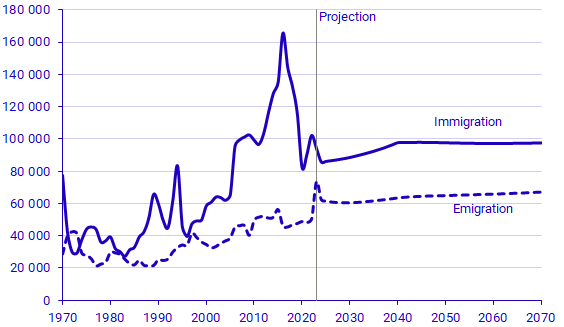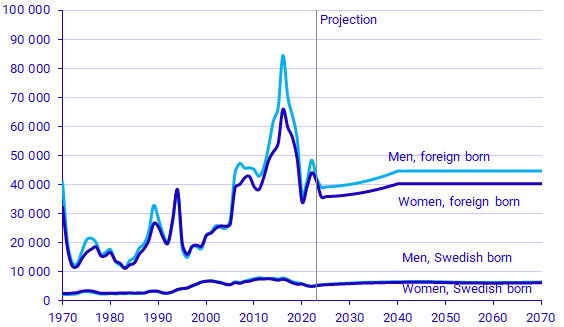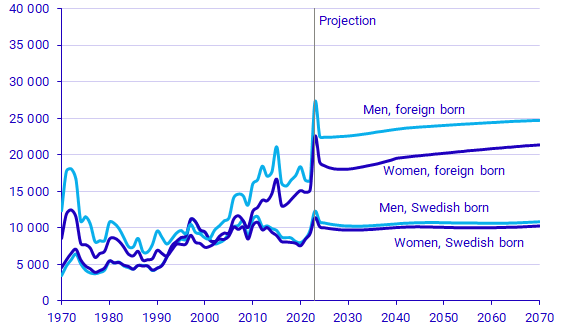Immigration and emigration 1970–2023 and projection 2024–2070
Immigration and emigration 1970–2023 and projection 2024–2070

Immigration by sex and country of birth 1970–2023 and projection 2024–2070

Emigration by sex and country of birth 1970–2023 and projection 2024–2070

Comments
The number of immigrants has varied over the years. The significant peaks of labour immigration at the end of the 1960s, refugees from Iran at the end of the 1980s and from Yugoslavia in the beginning of the 1990s are visible in the diagram. During the 2000s, the number of immigrants has increased, reaching an all-time-high in 2016. Since then, the immigration has decreased, but remained at a historically high level. There are several reasons for this: asylum seekers, returning native-born persons, immigration due to employment and studies, and immigration due to family reunification among both native- and foreign born persons all contribute to the number of immigrants to Sweden. Among refugees and labour migrants, there are more men than women, while more of the family migrants are women. During most years, but not all, there have been slightly higher immigration of foreign born men than of foreign born women. A consequence of the larger immigration of refugees, the surplus of men was higher in the middle of the last decade but has decreased since then. According to the Swedish population projection, more men than women will immigrate during the whole projection period.
In 2023, the number of individuals immigrating to Sweden was 94 514. This was the lowest number of immigrants since 2005, except for the years 2020 and 2021, when the migration was hampered by the Covid-19 pandemic. The projection for the next few years is that the number of new immigrants will increase slowly, towards a level of just below 98 000 per year. This is lower than the recent years but close to the annual average for the first two decades of the 21st century. The assumptions about future migration contain a higher degree of uncertainty, both in the short and in the long term. It is most likely that there will be significant year-to-year variation in the number of immigrants to Sweden in the following years, but it is difficult to predict when these peaks will occur. The level of immigration shown in the projection should be interpreted as an average around which the number of immigrants is expected to fluctuate. It is likely that immigration will continue to be affected by conflicts and political instability in the rest of the world, but immigration to Sweden of these reasons is expected to be lower than during the last decade. In the projection it is also expected that people will continue to move to Sweden for reasons other than conflicts and political instability.
The emigration of persons born in Sweden has seen an increasing trend for some time. Until the beginning of 1990s, about 10 000 Swedish-born persons emigrated every year. The number increased during the 1990s and since the late 1990s around 20 000 Swedish-born persons emigrated every year. However, the number of emigrants has decreased during the last decade. About the same number of Swedish-born men and women emigrated during the last ten years, although the number of men was slightly higher.
The emigration of foreign born persons follows a similar pattern. Until the beginning of the 21st century, there were about as many Swedish-born as foreign born emigrants. Thereafter, the number of foreign born emigrants has increased. This was influenced by the increase of the total foreign born population. Over the years, more foreign born men than foreign born women have emigrated. This trend is expected to continue during the projection period. Different groups have different tendencies to emigrate. Those who have come to Sweden as refugees or due to family ties have stayed in a greater extent, while those who immigrated to Sweden due to work or studies have left the country to a greater extent. The emigration rate has been relatively low during the last few years. This relates in part to a larger immigration of refugees, but the emigration rates have also been relatively low in other foreign born groups. According to the projection, the emigration will increase to its previous levels, partly due to a decrease in the proportion of refugees among the immigrants.
In the short term, this projection can be regarded as a population forecast. In the long term, the projection should be regarded as precisely a projection of the population in the case that current behaviour and trends continue in the future. Furthermore, an assumption is made that regulations that apply today will continue to apply throughout the projection period. Already in the short term, changes in society may mean that projection conditions will change.